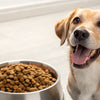Should You Add Water to Dog Kibble? A Comprehensive Guide for Pet Owners
- Houndsy
Table of Contents
- Introduction
- The Benefits of Adding Water to Dog Kibble
- The Drawbacks of Adding Water to Dog Kibble
- Practical Tips for Adding Water to Dog Kibble
- Conclusion
Introduction
Did you know that nearly 60% of dogs struggle to drink enough water daily? As responsible pet owners, we constantly seek ways to enhance our furry friends' health and well-being, especially when it comes to their nutrition. One common question that often arises is: Should you add water to dog kibble? This seemingly simple decision can significantly impact your dog's health, hydration, and mealtime enjoyment.
In this blog post, we will delve deep into the implications of adding water to dry dog food. We’ll explore the benefits and potential drawbacks, helping you make an informed choice that best suits your dog's needs. We'll also touch upon how our flagship product, the Houndsy Kibble Dispenser, provides a convenient and stylish way to serve your dog’s meals, whether served dry or moistened.
By the end of this post, you will have a thorough understanding of whether adding water to your dog's kibble is the right choice, along with practical tips on how to implement it safely. So, let’s embark on this journey together as we enhance our pets’ feeding experience!
The Benefits of Adding Water to Dog Kibble
Enhanced Palatability
One of the most immediate benefits of adding water to dog kibble is the enhancement of palatability. Many dogs can be picky eaters, and dry kibble sometimes lacks the aroma and flavor necessary to entice them. By moistening the kibble with water, you can unlock and amplify the natural flavors and smells, making mealtime more appealing.
Imagine transforming a mundane bowl of dry kibble into a savory, aromatic dish that makes your dog's tail wag with anticipation. For finicky eaters, this simple addition can make all the difference!
Improved Hydration
Proper hydration is crucial for maintaining your dog's overall health, yet many dogs do not drink enough water on their own. Adding water to kibble can help increase their fluid intake, especially for those who may be reluctant to drink from their bowls. This is particularly beneficial for active dogs, older dogs, or breeds that are prone to dehydration.
Think of it this way: by adding water to your dog's kibble, you are not just making their food tastier; you are also providing them with an additional source of hydration that can support their bodily functions, digestion, and energy levels.
Easier to Chew and Digest
Moistening dry kibble can also make it softer and easier to chew, which is especially helpful for older dogs or those with dental issues. The added moisture allows for a gentler eating experience, reducing the risk of choking or discomfort.
Moreover, softened kibble is often easier for dogs to digest. The moist environment helps break down the food more effectively, potentially reducing the likelihood of digestive upset, particularly in sensitive stomachs. A gentler approach to mealtime can ensure that your dog enjoys their food without any stress or discomfort.
Dental Health Considerations
While dry kibble is often praised for its dental benefits—its crunchy texture can help scrape plaque off your dog’s teeth—moistened kibble can serve as a suitable alternative for dogs with dental problems. For dogs suffering from sore gums or broken teeth, softer food can make mealtime much more comfortable.
However, it’s important to note that while softened kibble can be easier on the teeth, it may not provide the same level of dental cleaning as dry kibble. Therefore, if dental health is a priority, you might want to consider alternating between dry and moistened kibble, or even consulting with your veterinarian for tailored advice.
The Drawbacks of Adding Water to Dog Kibble
Potential for Spoilage
One of the significant downsides of adding water to kibble is the potential for spoilage. Wet kibble can create an environment conducive to bacterial growth, especially if left out for too long. If you choose to moisten your dog's food, it’s essential to serve it immediately and discard any leftovers after about 60 minutes to prevent spoilage and protect your dog from potential gastrointestinal issues.
This concern is especially relevant in warmer climates where bacteria can proliferate more readily. Hence, careful meal management is key when transitioning to moistened kibble.
Changes in Feeding Routine
Introducing water to your dog’s kibble can alter their feeding routine. Some dogs may take longer to eat moist food than dry kibble, which could lead to frustration or behavioral issues if they are accustomed to finishing their meals quickly.
Additionally, if your dog has been eating dry kibble for a long time, the change in texture and consistency could take some getting used to. Monitoring your dog's response to the new feeding method is crucial, and it may require a gradual introduction to help them adjust comfortably.
Dental Health Implications
As mentioned earlier, while adding water to kibble can alleviate discomfort for dogs with dental issues, it can also reduce the dental benefits typically associated with dry kibble. The abrasive action of chewing dry kibble helps clean teeth and gums, potentially preventing plaque buildup and gingivitis.
If your dog has healthy teeth and gums, you may want to limit the amount of moistened kibble to ensure they continue to benefit from the dental cleaning properties of dry food.
Nutritional Considerations
Lastly, it's worth noting that adding water can potentially alter the nutritional profile of your dog’s food. Some vitamins and minerals may dissolve into the water, especially if the kibble is left to soak for an extended time. While the loss of nutrients may not be significant, over time, it could lead to deficiencies, particularly with water-soluble vitamins.
To prevent this from happening, it’s best to add water just before mealtime rather than letting the kibble soak for long periods. Consulting with your veterinarian about your specific brand of kibble can also help ensure that you’re not compromising your dog's nutritional intake.
Practical Tips for Adding Water to Dog Kibble
If you decide that adding water to your dog’s kibble is the right choice, here are some practical tips to make the process easier and safer:
- Start Slowly: If your dog is accustomed to dry kibble, introduce moistening gradually. Begin by adding a small amount of water and increasing it as your dog adjusts to the new texture.
- Use Warm Water: Using warm (not hot!) water can help release the flavors and aromas of the kibble, making it more enticing for your dog. Warm water can also help softening the kibble more effectively.
- Serve Immediately: Always serve moistened kibble right after preparing it. Discard any uneaten food after about 60 minutes to prevent spoilage and protect your dog’s health.
- Monitor Reactions: Keep an eye on your dog’s response to the new feeding routine. If they seem hesitant or experience any digestive issues, consult with your veterinarian.
- Consider Individual Needs: Every dog is unique, and factors like age, breed, and health conditions play a vital role in determining whether adding water to kibble is beneficial. Tailor your approach based on your dog’s specific needs.
Conclusion
The question of whether you should add water to dog kibble is multifaceted, with both benefits and drawbacks to consider. Enhanced palatability, improved hydration, and easier digestion are compelling reasons to make the switch, especially for picky eaters or dogs with special needs. However, potential spoilage, dental health implications, and nutritional considerations warrant careful management.
Ultimately, the decision should be based on your dog's individual preferences and health requirements. As always, we recommend consulting with your veterinarian to ensure that any changes to your dog’s diet are safe and beneficial.
As we continuously strive to enhance our pet care practices, let’s not forget the importance of convenience and style in our feeding routines. The Houndsy Kibble Dispenser is designed to elevate your dog’s feeding experience with its mid-century modern aesthetic, ergonomic convenience, and perfect portion control. Explore how our Kibble Dispenser can simplify your dog's feeding rituals while complementing your home decor—because we believe that feeding time should be a beautiful experience. Order Now.
FAQ
1. Is it safe to add water to dog kibble? Yes, it is generally safe to add water to dog kibble. However, you should ensure that the moistened food is consumed promptly to prevent spoilage.
2. Can adding water help my picky eater? Absolutely! Adding water can enhance the flavor and aroma of kibble, making it more appealing to picky eaters.
3. How much water should I add to kibble? Start with about a quarter cup of water for each cup of kibble, adjusting based on your dog's preferences and the kibble's texture.
4. Will adding water to kibble affect my dog's dental health? Moistened kibble may not provide the same dental benefits as dry kibble since it lacks the abrasive texture that helps clean teeth. Consider alternating between dry and moistened kibble if dental health is a priority.
5. Can I leave moistened kibble out for the day? No, it’s best to serve moistened kibble immediately and discard any leftovers after an hour to reduce the risk of bacterial growth.













